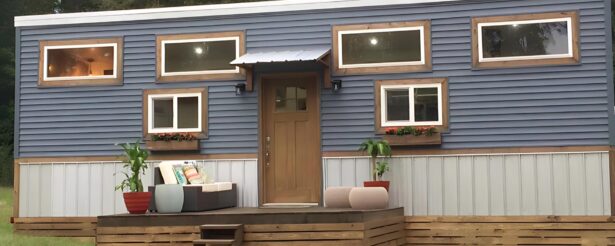Derek Ezell, UT Martin assistant professor of marketing, and his wife have a little piece of real estate that they called home for more than four years while living in Mississippi and South Carolina.
Ezell (Martin ’09) and his wife, Sierra (Martin ’09), along with their fathers built what is known as a tiny house, 256 square feet in space measuring 32 feet long by 8 feet wide and 10 feet high.
The idea of living in a tiny house came out of necessity, with little income as a doctoral student at the University of Mississippi in an area with a high cost of living.
“Though it’s a fairly small town to have such a large school there, the cost of living is pretty high,” Ezell says. “I don’t think it’s any secret that the stipend that they give Ph.D. students is not very high, either.”
While looking for cheap housing alternatives, they came across tiny houses and decided to try it. The couple researched and planned, then built for six months before they finally had their two-room home.
“We built it in Martin while I was going to school there (in Mississippi),” he says. “Long weekends here (in Martin), school there (in Mississippi) and coming back again.”
“After six months, we took it down to Oxford, Mississippi, to be there permanently. After graduating, I took a full-time position in Greenwood, South Carolina, so we hauled it all the way to Greenwood. Now, it’s back in Tennessee.”
The couple’s life in a tiny house became the basis for Ezell’s doctoral dissertation.
“Our society is very consumption-generated, and (living in a tiny house) is kind of anti-consumption,” he says. “For my wife and I to be able to fit in this, we did a lot of downsizing and getting rid of things that we didn’t need.”
“It was kind of a cathartic process, just realizing how much extra we had and what little we needed to be happy. That’s where the dissertation went: this anti-consumption and still being happy or even reprioritizing needs so that you don’t have a big house, but you can enjoy doing things, seeing nature, things like that more.”
In planning the house, the couple taped out the house’s measurements in the driveway to help them visualize the space.
“There was a lot of troubleshooting during the process, too,” he says. “We kind of built on it and adapted it as we went. It was all we needed.”
The couple had help in the build from Ezell’s father, who owned a construction business; his grandfather, who was an electrician; and his father-in-law, who was an experienced builder.
Ezell compared the tiny home to living in a mobile home, with galley-style storage in cabinets at eye level and at foot level. The living conditions didn’t feel cramped.
“They weren’t bad,” he says. “We had six big 4-foot-by- 2-foot picture windows that added a lot of light and made it feel more spacious, and we had a few smaller windows added to that.”
They fit in a full-size fridge, oven, stove, microwave and dishwasher.
“As far as amenities, we fit as many as we could into the small footprint,” he says. “We had a big enough hot-water heater to enable multiple people to take showers back-to-back and not worry about it. We had a big double-basin sink that my father-in-law liked to pick on me for because it was very big.”
The Ezells finished the tiny house in January 2017 and lived in it until they moved to Martin from South Carolina in 2021. Ezell said that one misconception about tiny houses is that they are extremely cramped.
“People think that you have to sacrifice a lot to live in a tiny house, but that’s not the case,” he says. “It wasn’t that big a deal. We were very much of the mindset that we could sacrifice a little here as far as space and travel more and do things we like to do like concerts and things like that.”
The couple found cities have varying regulations for tiny houses, which can make it difficult to live in one full time. In Mississippi and South Carolina, the couple lived outside of the city limits to make it work.
When the couple returned to Martin, they moved into a 2,000-square-foot house.
“We had a newborn that would add some layers of difficulties in the tiny house, as there are some exposed ledges and unsafe areas for a small child,” Ezell says.
Four years living in a tiny house was not burdensome to the couple.
“For all of the obvious difficulties of living in a tiny house, it was never an issue for us,” Ezell says. “We enjoyed it. That’s obviously the reason we kept it and still want to be able to use it from time to time.”
The Ezells’ tiny house now sits near Paris Landing outside of Springville.
“It’s kind of a getaway house right now,” Ezell says.
“It’s all you need at the lake because you want to be outside anyway.”

